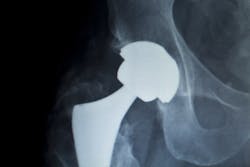In 2025, it will become mandatory for hospitals under the Hospital Inpatient Quality Reporting (IQR) program to collect and report patient-reported outcomes for at least half of eligible total hip/total knee replacement patients. Healthcare Innovation recently sat down with 13-hospital Geisinger Health System’s Michael Suk, M.D., J.D., M.P.H., M.B.A., and Bronwyn Spira, CEO and co-founder of Force Therapeutics, a digital care management platform for musculoskeletal care, to discuss the implications of these changes.
Force Therapeutics is a company that gives orthopedic patients access to customized education and virtual physical therapy throughout an episode of care. Prior to co-founding Force, Spira ran the Inpatient Rehab department at Rusk Rehabilitation Center at NYU Langone Health before founding and managing a New York-based multi-clinic orthopedic rehabilitation practice.
Suk is chief physician officer for Geisinger System Services and Chair of the Geisinger Musculoskeletal Institute based in Danville, Pa.
A recent study looked at aggregated real-world data from nearly 55,000 patients from four Force Therapeutics health system partners – Geisinger Health, Hartford Healthcare, ValueHealth, and Columbia Orthopaedic Group – across more than 25 facilities and over 200 providers.
Patients included in the report underwent a wide range of hip, knee, shoulder, and spine procedures, providing thousands of data points to evaluate utilization, patient experience, and outcomes based on standard scoring tools for clinical benefit, function, disability, mental health, and well-being.
Force noted that surgical preparedness and patient engagement were critical contributors to positive outcomes:
- 95 percent of patients using the Force Therapeutics platform felt “very prepared” for surgery.
- 83 percent average compliance with patient-reported outcomes measures (PROMs) was achieved across patients on the Force Therapeutics platform.
- 95 percent of patients using Force Therapeutics understood their post-discharge pain management plans “very clearly” or “clearly.”
- 90 percent of patients reported being “satisfied” or “very satisfied” with their surgical episodes combined with Force Therapeutics’ care management plans.
- 87 percent of patients logged their pain in the Force Therapeutics platform, with each patient submitting 18 entries on average.
HCI: Has there been a shift or evolution in the use of patient-reported outcomes and how regulators are starting to expect providers to include those in some kind of quality reporting effort?
Spira: Definitely. And, you know, the latest shift is a big one. CMS is now mandating the collection of patient-reported outcome measures. Systems that are working with Medicare patients actually have to collect patient-reported outcomes starting in April of 2024 or they'll be subject to penalties by April of 2025.
HCI: Are they just doing this in orthopedics first or in a lot of different specialties?
Spira: I think CMS has started the mandates in orthopedics specifically with a focus on total joint replacements because total joints are very high-volume procedures with a lot of variability. So as the government looks at all the claims data and the amount of money they're spending, if they see that a procedure in New Jersey costs double what that same procedure costs in California, they're going to say there's something going on here. But you can't change anything until you measure the quality. So if somebody's costing half, but the outcome is terrible, that's not good. CMS is being thoughtful about looking at the cost piece, looking at where the variation happens, and asking how can we remove the variation and reduce the cost, but saying in addition to managing the cost, we have to also monitor those outcomes.
HCI: Previously, they might have just been looking at things like rehospitalizations or infections and not gotten to that granular data about the patient's perception of whether the surgery helped with quality of life.
Spira: As a healthcare system in this country, we have to look at the big picture, and readmissions and complications are just the tip of the iceberg. How satisfied is their patient with their surgery? Outcomes that matter to patients are also important. Can they return to work or become a productive member of society? Can they return to their activities and quality of life? Those are an increasingly important piece of the puzzle in terms of what we can measure.
HCI: Dr. Suk, could you talk about your initial interest in working with Force Therapeutics and what your experience has been?
Suk: I think we started working with them in 2016. If you think about it, the world has changed since then. The idea of using digital health as a part of an orthopedic episode was really very cutting edge at the time. In our department, as we were debating different things around this concept of value-based care, we saw an opportunity to determine whether or not initially we could identify patients who didn't have to go to a post-acute care facility. Today, we recognize that most patients don’t need to be sent to a post-acute care facility. But back in 2016, we were the first to really begin asking patients to go home and have their post-acute care managed with a digital intervention. I think some of the early work that we did set the bar for what has now become almost a standard of care, in in terms of people's expectations to go home, be connected and stay in touch with not only their physician, but with their care plan.
HCI: In July Force Therapeutics released a study highlighting some of the value of a digital health plan in orthopedics, and Geisinger was one of the organizations involved. Can you talk about that study?
Suk: It is a retrospective review of our data. We had seven years of data at Geisinger and other health systems. We reviewed their satisfaction with digital connectivity — their facility with using an app, whether or not they felt connected to their providers, even though they weren't coming in to see them physically. When we are in a traditional orthopedic episode, a physician would see the patient at two weeks, at six weeks and then at 12 weeks. But we had virtually no idea what's happening in between. The whole idea of creating digital care with continuous monitoring and feedback was a way for us to know what happened between the surgery and two weeks, two weeks and six weeks and get a sense of whether they were doing their exercises that would contribute ultimately to their outcomes. We looked at all of the data to determine their levels of satisfaction, how they felt about the program in the first place. And the aggregate report shows extremely high levels of satisfaction.
HCI: Bronwyn mentioned it is going to become mandatory for hospitals to collect and report on these patient-reported outcomes and risk variables. How huge of a change is that going to be for health systems and orthopedic specialists if they haven't already been going down this road like Geisinger has for several years?
Suk: I think that there are two ways to look at that. One is I think cognitively orthopedic surgeons are aware that they're going to need to do this. I think most institutions are not prepared. There's a sense that we have got to do this, and waiting for the hammer to drop if payments going to be tied to it. Because as soon as they put a penny to it, everyone's going to do it, right? Institutions are going to find themselves in a bit of a challenge because they don't have the workflow. You can always buy software to capture outcomes, but figuring out the workflow actually takes quite a bit of time. Most doctors are very busy in a practice, and the last thing they want to do is have someone spend an extra 10 minutes doing something new. It just curtails our overall efficiency. That's where you get a lot of push-back. Institutions that are in a position to help would be best off trying to figure out not only what software to use, but also how best to integrate it into patient care workflow. As you point out, we've had a seven-year head start. When we first started, we were a bit of an outlier. And I enjoyed that quite a bit. Today, I think a lot of organizations are recognizing they need to do it, and are asking us how we do it.
HCI: It seems like this could have big implications for referral patterns and success in value-based care arrangements if you have this already set up in the workflow and up and running rather than trying to scramble to make it happen.
Suk: I think the best way to look at it in the context of value-based care is that essentially, we are promising better outcomes for lower costs. We can always cut costs, right? That's pretty easy on a financial ledger. But tracking outcomes is a totally different story. How do I know if whether what I did was cheaper and actually ended up with a better result? You have to ask, No. 1, are you any good? No. 2, are you getting better? And No. 3 is how do you know? People struggle with the third question. It's the collection of outcomes data that drives that reality.
HCI: Are there next steps or other things you want to do to fine-tune this work?
Suk: Outcomes assessment is going to start to become ubiquitous, but we recognize that orthopedics is extremely multivariable, right? It's very hard to think about how many outcomes we have in orthopedic surgery because of all the different anatomies. If I do an outcomes assessment on a total joint procedure and I use the same one on a knee fracture, and if pain is a component of it, I'm going to look really bad as a knee fracture surgeon. So I want a new outcome assessment, right? We're at a crossroads now. On the one hand, we want to make it easy for people to collect the data, but we also want it to be meaningful, so we tend to collect general health scores that can apply to everybody. Then we try to pick one or two that can be universally applied to an anatomic region. I think in the future, if we're going to do this right, we would have very specific outcome measures for very specific procedures. I think that's a little out of reach for us right now. I think outcome measurements are here to stay, but we still have quite a bit of work to refine them.
HCI: Are you glad that CMS is starting to include these in requirements?
Suk: I'm glad in a sense, because we've been advocating for it for a long time. A lot of us have been evangelists for the idea of collecting outcomes data. CMS is a big driver of people doing something. I think there's always a question or whether that driver is going to do it right. I think it's the right step, but we have to continue to refine what we do.
HCI: Bronwyn, do you think these new requirements from CMS are likely to lead to rapid growth for your company?
Spira: We really are seeing a rapid influx of new clients right now because I do feel that a lot of organizations, if they're even collecting patient-reported outcomes, they're doing it by hand on paper. So now that CMS has mandated it, we're seeing a lot of organizations that are trying to catch up and to Dr Suk’s point, the workflow stuff is what's difficult. How do you implement it? How do you integrate it with the EHR? How do you train staff and configure the platform so that it's easy for the team to use. We know that care team burnout is real. You have to create a way that they can be more efficient and able to do their job more efficiently and collect these outcomes. There's a lot of wood to chop in getting some of these organizations up to speed. Geisinger and a couple of the other organizations that were early adopters are off to the races and they're set to go. But, you know, some of these newer organizations that, have lagged behind or haven't really put in place certain digital strategies or infrastructures are going to have to hustle to catch up.


